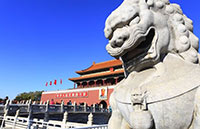Plagiarism the bane of animation industry
Updated: 2015-07-11 07:46
By Xiao Lixin(China Daily)
|
||||||||
Made-in-China animations have seen what many consider a "golden period". People still talk about some Chinese animations. Take Uproar in Heaven, the international-award-winning animation of 1961, for example. Its every scene looks like a fine painting, because the production team used such methods as stamp mark technique in Wuxi Paper Horse (woodblock color or black-and-white paper prints used for folk sacrifice from East China's Jiangsu province), and learned from the murals in Yongle Palace in Shanxi province, North China, to design every character and weapon to present millenniums-old Chinese culture.
Even in the past decade, Chinese animations held some promise thanks to the government's subsidy policy to help develop the animation industry. China even overtook Japan in 2011 as the top producer of cartoon films in terms of total length. But the situation remained unsatisfactory when it came to quality.
Despite its good intentions, the policy designed to subsidize productions by the minute also has attracted and been exploited by quite a few money-minded speculators. With no authoritative organization that can effectively supervise the animation industry and identify copycat productions, people can use the policy to simply plagiarize to cut costs and still go unpunished.
This plagiarizing tendency is also associated with the social environment where intellectual property and originality don't get due respect. Thus, those choosing the easy way out can make more profits easily in the short term while good animators continue to suffer.
Worse, even in the long run the existing social environment could make it difficult to safeguard good animators' legitimate rights and interests. More often than not, independent illustrators whose original works are "stolen" after being posted on the Internet have tried to use social media like micro blogs to seek justice, but the copycats, despite facing online criticisms, have rarely apologized or received proper punishment.
Back to The Autobots. According to its director, it is designed to encourage children to think independently and pursue creativity and innovativeness. But what the director and his team have done is just the opposite and set a bad example to follow.
The author is a writer with China Daily. xiaolixin@chinadaily.com.cn
(China Daily 07/11/2015 page5)
- Magic of Disney animation comes to Beijing
- Ningbo's animation industry showcases its potential
- Int'l Cartoon and Animation Festival held in Hangzhou
- Korean master of animation seeks inspiration from Chinese writers
- China International Cartoon and Animation Festival kicks off
- Overseas interest in Chinese cartoon and animation industry grows
- A breakthrough in Chinese animation
- 3D Kunqu opera animation finishes filming
- Animation based on paintings brings Qing glory to the fore
- Global health entering new era: WHO chief
- Brazil's planning minister steps aside after recordings revelation
- Vietnam, US adopt joint statement on advancing comprehensive partnership
- European border closures 'inhumane': UN refugee agency
- Japan's foreign minister calls A-bombings extremely regrettable
- Fukushima impact unprecedented for oceans: US expert

 Stars of Lijiang River: Elderly brothers with white beards
Stars of Lijiang River: Elderly brothers with white beards
 Wealthy Chinese children paying money to learn British manners
Wealthy Chinese children paying money to learn British manners
 Military-style wedding: Fighter jets, grooms in dashing uniforms
Military-style wedding: Fighter jets, grooms in dashing uniforms
 Striking photos around the world: May 16 - May 22
Striking photos around the world: May 16 - May 22
 Robots help elderly in nursing home in east China
Robots help elderly in nursing home in east China
 Hanging in the air: Chongqing holds rescue drill
Hanging in the air: Chongqing holds rescue drill
 2.1-ton tofu finishes in two hours in central China
2.1-ton tofu finishes in two hours in central China
 Six things you may not know about Grain Buds
Six things you may not know about Grain Buds
Most Viewed
Editor's Picks

|

|

|

|

|

|
Today's Top News
Liang avoids jail in shooting death
China's finance minister addresses ratings downgrade
Duke alumni visit Chinese Embassy
Marriott unlikely to top Anbang offer for Starwood: Observers
Chinese biopharma debuts on Nasdaq
What ends Jeb Bush's White House hopes
Investigation for Nicolas's campaign
Will US-ASEAN meeting be good for region?
US Weekly

|

|









